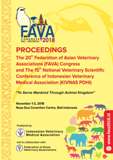JSPS-4 Preliminary Investigation of Bovine Respiratory Disease Complex in Indonesia
Abstract
Bovine Respiratory Disease Complex (BRDC) has been recognized as a major cause of cattle morbidity and mortality throughout the world, which greatly affects beef and dairy cattle industries. It develops as a result of complex interactions between environment, cattle, and pathogens. Multiple viral or bacterial agents have been documented in BRDC cases. These include Bovine Herpesvirus 1 (BoHV-1), Bovine Viral Diarrheal Virus (BVDV), and Bovine Parainfluenza Virus-3 (BPIV-3), Bovine Respiratory Syncytial Virus (BRSV); Bovine Coronavirus, Bovine influenza D Virus, Bovine Rhinitis A and B viruses, Bovine Adenovirus, Mannheimia haemolytica (MH), Pasteurella multocida (PM), Histophilus somni (HS), Klebsiella pnemoniae, Truperella pyogenes, Ureaplasma diversum, and Mycoplasma bovis (MB) (1). Indonesia imports considerable number of life beef and dairy cattle from Australia and New Zealand. Close proximity of cattle in a high-density during transportation and stress related to dramatic environmental changes often give rise to significant losses due to respiratory diseases. Accordingly, feedlot and dairy cattle in Indonesia are likely to have high risk of experiencing BRDC. This preliminary study was aimed to investigate the occurrence of BRDC and to identify its associated pathogens in beef and dairy cattle in limited area of western Java.

